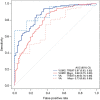Developing prediction models for clinical use using logistic regression: an overview
- PMID: 31032076
- PMCID: PMC6465431
- DOI: 10.21037/jtd.2019.01.25
Developing prediction models for clinical use using logistic regression: an overview
Abstract
Prediction models help healthcare professionals and patients make clinical decisions. The goal of an accurate prediction model is to provide patient risk stratification to support tailored clinical decision-making with the hope of improving patient outcomes and quality of care. Clinical prediction models use variables selected because they are thought to be associated (either negatively or positively) with the outcome of interest. Building a model requires data that are computer-interpretable and reliably recorded within the time frame of interest for the prediction. Such models are generally defined as either diagnostic, likelihood of disease or disease group classification, or prognostic, likelihood of response or risk of recurrence. We describe a set of guidelines and heuristics for clinicians to use to develop a logistic regression-based prediction model for binary outcomes that is intended to augment clinical decision-making.
Keywords: Review; logistic regression; predictive model.
Conflict of interest statement
Conflicts of Interest: The authors have no conflicts of interest to declare.
Figures


Similar articles
-
Predicting 30-day Hospital Readmission with Publicly Available Administrative Database. A Conditional Logistic Regression Modeling Approach.Methods Inf Med. 2015;54(6):560-7. doi: 10.3414/ME14-02-0017. Epub 2015 Nov 9. Methods Inf Med. 2015. PMID: 26548400
-
Building interpretable predictive models for pediatric hospital readmission using Tree-Lasso logistic regression.Artif Intell Med. 2016 Sep;72:12-21. doi: 10.1016/j.artmed.2016.07.003. Epub 2016 Jul 29. Artif Intell Med. 2016. PMID: 27664505
-
From algorithms to action: improving patient care requires causality.BMC Med Inform Decis Mak. 2024 Apr 26;24(1):111. doi: 10.1186/s12911-024-02513-3. BMC Med Inform Decis Mak. 2024. PMID: 38664664 Free PMC article.
-
Prognostic and Prediction Tools in Bladder Cancer: A Comprehensive Review of the Literature.Eur Urol. 2015 Aug;68(2):238-53. doi: 10.1016/j.eururo.2015.01.032. Epub 2015 Feb 21. Eur Urol. 2015. PMID: 25709027 Review.
-
An introduction to clinical prediction models using logistic regression in acute care surgery research: Methodologic considerations and common pitfalls.J Trauma Acute Care Surg. 2025 May 1;98(5):699-703. doi: 10.1097/TA.0000000000004584. Epub 2025 Feb 27. J Trauma Acute Care Surg. 2025. PMID: 40012096 Review.
Cited by
-
Novel ensemble learning approach with SVM-imputed ADASYN features for enhanced cervical cancer prediction.PLoS One. 2024 Jan 10;19(1):e0296107. doi: 10.1371/journal.pone.0296107. eCollection 2024. PLoS One. 2024. PMID: 38198475 Free PMC article.
-
Special Issue "Cancer Biomarker Research and Personalized Medicine 2.0".J Pers Med. 2024 May 21;14(6):549. doi: 10.3390/jpm14060549. J Pers Med. 2024. PMID: 38929770 Free PMC article.
-
Prognostic value of screening instrument based on the Dutch national VMS guidelines for older patients in the emergency department.Eur Geriatr Med. 2021 Feb;12(1):143-150. doi: 10.1007/s41999-020-00385-0. Epub 2020 Sep 1. Eur Geriatr Med. 2021. PMID: 32870476 Free PMC article.
-
Using Machine Learning Algorithms to Pool Data from Meta-Analysis for the Prediction of Countermovement Jump Improvement.Int J Environ Res Public Health. 2023 May 19;20(10):5881. doi: 10.3390/ijerph20105881. Int J Environ Res Public Health. 2023. PMID: 37239607 Free PMC article.
-
Predicting red blood cell transfusion for primary hip and knee arthroplasty: Designing a hub and spoke high-volume arthroplasty model.J Clin Orthop Trauma. 2025 Mar 12;64:102974. doi: 10.1016/j.jcot.2025.102974. eCollection 2025 May. J Clin Orthop Trauma. 2025. PMID: 40182683
References
-
- Harrell FE. Regression Modeling Strategies. 2nd ed. New York City, NY: Springer Science + Business Media, 2015.
-
- Steyerberg EW. Clinical Prediction Models. 1st ed. New York City, NY: Springer-Verlag New York, 2009.
Publication types
Grants and funding
LinkOut - more resources
Full Text Sources
Other Literature Sources
